Results - Sharks and Rays
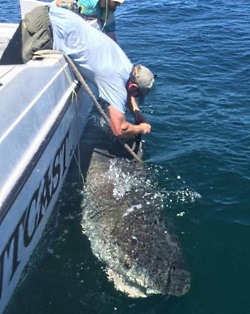
Twelve shark and three ray species were detected by acoustic receivers off SC and GA, of which only two species (tiger and bonnethead sharks) were tagged locally by SCDNR researchers.
Three other researchers also tagged tiger sharks that were detected off SC and GA, but 91% of transmitter days of data were associated with tiger sharks tagged by SCDNR researchers. Across species and researchers, tiger sharks comprised 45% of transmitter days of data collected for large coastal sharks.
In contrast, bonnethead sharks tagged by a non-SCDNR researcher accounted for 35% of transmitter days of data collected off SC and GA. Across species and researchers, bonnethead sharks only accounted for 3% of the small coastal group.
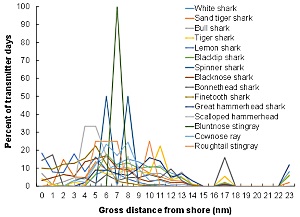
Independent of the size of tagged sharks and rays or the time of year when they were detected, this group of animals occurred across a wide range of distances from shore. Only a third of shark and ray species were detected within a mile of inlets, with a steady increase in the number of species detected with increasing distance from shore such that all shark and ray species were detected seven miles offshore. A steady decline in shark and ray detections was also noted between seven and 14 miles from shore, as well as the detection of only one-third of shark and ray species 23 miles offshore (note: lack of data between 14 and 23 miles offshore reflects lack of receivers).
Prohibited Take Sharks
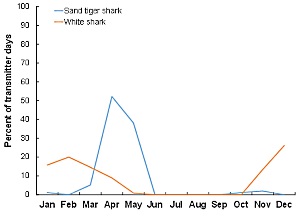
Two prohibited take species (white and sand tiger sharks) comprised 14% of all transmitter days of data collected for shark and ray species off SC and GA. Sand tiger sharks were detected during six months of the year, but 90% of data were generated during April and May. White sharks occurred in coastal waters off SC and GA during seven months of the year, but 90% of data for this species was generated between November and March. These detection patterns suggest a migratory movement of sand tigers in spring, but perhaps over-wintering by white sharks.
- View detection animations for prohibited sharks
- Species information for sand tiger sharks
- Species information for white sharks
Large Coastal Sharks
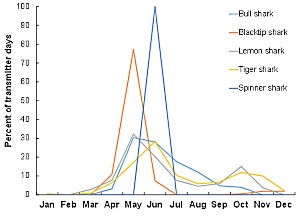
Large coastal sharks comprised 32% of all transmitter days of data collected for shark and ray species SC and GA coastal waters. Peak occurrence for this group varied between April and June across species. Smaller secondary peaks in frequency of occurrence in October and November were also noted for tiger and lemon sharks following a general decline in summer months. Tiger sharks were detected in all months except February. Exclusive detection of spinner sharks in June reflects very limited data collected for this species.
- View detection animations for large coastal sharks
- Species information for Blacktip Shark
- Species information for Bull Shark
- Species information for Lemon Shark
- Species information for Spinner Shark
- Species information for Tiger Shark
Small Coastal and Hammerhead sharks

Small coastal sharks comprised 50% of all shark and ray detections off SC and GA. Three species of small coastal sharks were detected, but finetooth and blacknose sharks accounted for 72% and 25% of transmitter days of data collected for this group, respectively. In contrast to prohibited and large coastal sharks, these two species were detected monthly between March and December. Bonnethead sharks were detected in all months except February and May through September; however, it is unclear whether lack of late spring to late summer detections reflects seasonal movement or limited numbers of acoustically-tagged bonnethead sharks in the survey area. In contrast, limited observations for great hammerhead sharks tagged by researchers at distant locations portray a clear May to October detection window off SC and GA.
- View a detection animation for small coastal and hammerhead sharks
- Species information for Blacknose Shark
- Species information for Bonnethead
- Species information for Finetooth Shark
- Species information for Scalloped Hammerhead
- Species information for Great Hammerhead
Rays
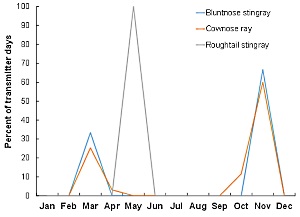
Three ray species comprised 2% of shark and ray detections off SC and GA. Bimodal detection patterns for several dozen cownose rays tagged in Chesapeake Bay suggests the importance of SC and GA coastal waters during migration between summer foraging and over-wintering grounds. A similar bimodal pattern was also observed for a single bluntnose stingray tagged by researchers at a partner institution in GA. Detection of a single roughtail stingray in May following tagging in FL was consistent with a northward spring migration.
